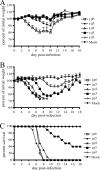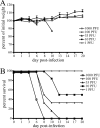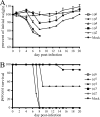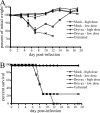Identification of wild-derived inbred mouse strains highly susceptible to monkeypox virus infection for use as small animal models
- PMID: 20519404
- PMCID: PMC2916512
- DOI: 10.1128/JVI.00621-10
Identification of wild-derived inbred mouse strains highly susceptible to monkeypox virus infection for use as small animal models
Abstract
Infection with monkeypox virus (MPXV) causes disease manifestations in humans that are similar, although usually less severe, than those of smallpox. Since routine vaccination for smallpox ceased more than 30 years ago, there is concern that MPXV could be used for bioterrorism. Thus, there is a need to develop animal models to study MPXV infection. Accordingly, we screened 38 inbred mouse strains for susceptibility to MPXV. Three highly susceptible wild-derived inbred strains were identified, of which CAST/EiJ was further developed as a model. Using an intranasal route of infection with an isolate of the Congo Basin clade of MPXV, CAST/EiJ mice exhibited weight loss, morbidity, and death in a dose-dependent manner with a calculated 50% lethal dose (LD(50)) of 680 PFU, whereas there were no deaths of BALB/c mice at a 10,000-fold higher dose. CAST/EiJ mice exhibited greater MPXV sensitivity when infected via the intraperitoneal route, with an LD(50) of 14 PFU. Both routes resulted in MPXV replication in the lung, spleen, and liver. Intranasal infection with an isolate of the less-pathogenic West African clade yielded an LD(50) of 7,600 PFU. The immune competence of CAST/EiJ mice was established by immunization with vaccinia virus, which induced antigen-specific T- and B-lymphocyte responses and fully protected mice from lethal doses of MPXV. The new mouse model has the following advantages for studying pathogenesis of MPXV, as well as for evaluation of potential vaccines and therapeutics: relative sensitivity to MPXV through multiple routes, genetic homogeneity, available immunological reagents, and commercial production.
Figures








References
-
- Chen, N., G. Li, M. K. Liszewski, J. P. Atkinson, P. B. Jahrling, Z. Feng, J. Schriewer, C. Buck, C. Wang, E. J. Lefkowitz, J. J. Esposito, T. Harms, I. K. Damon, R. L. Roper, C. Upton, and R. M. Buller. 2005. Virulence differences between monkeypox virus isolates from West Africa and the Congo basin. Virology 340:46-63. - PMC - PubMed
-
- Davis, R. C., A. Jin, M. Rosales, S. Yu, X. Xia, K. Ranola, E. E. Schadt, and A. J. Lusis. 2007. A genome-wide set of congenic mouse strains derived from CAST/Ei on a C57BL/6 background. Genomics 90:306-313. - PubMed
-
- Earl, P. L., J. L. Americo, L. S. Wyatt, L. A. Eller, D. C. Montefiori, R. Byrum, M. Piatak, J. D. Lifson, R. R. Amara, H. L. Robinson, J. W. Huggins, and B. Moss. 2007. Recombinant modified vaccinia virus Ankara provides durable protection against disease caused by an immunodeficiency virus as well as long-term immunity to an orthopoxvirus in a non-human primate. Virology 366:84-97. - PMC - PubMed
-
- Earl, P. L., J. L. Americo, L. S. Wyatt, O. Espenshade, J. Bassler, K. Gong, S. Lin, E. Peters, L. Rhodes, Jr., Y. E. Spano, P. M. Silvera, and B. Moss. 2008. Rapid protection in a monkeypox model by a single injection of a replication-deficient vaccinia virus. Proc. Natl. Acad. Sci. U. S. A. 105:10889-10894. - PMC - PubMed
Publication types
MeSH terms
Substances
Grants and funding
LinkOut - more resources
Full Text Sources
Other Literature Sources
Medical
Research Materials
Miscellaneous

